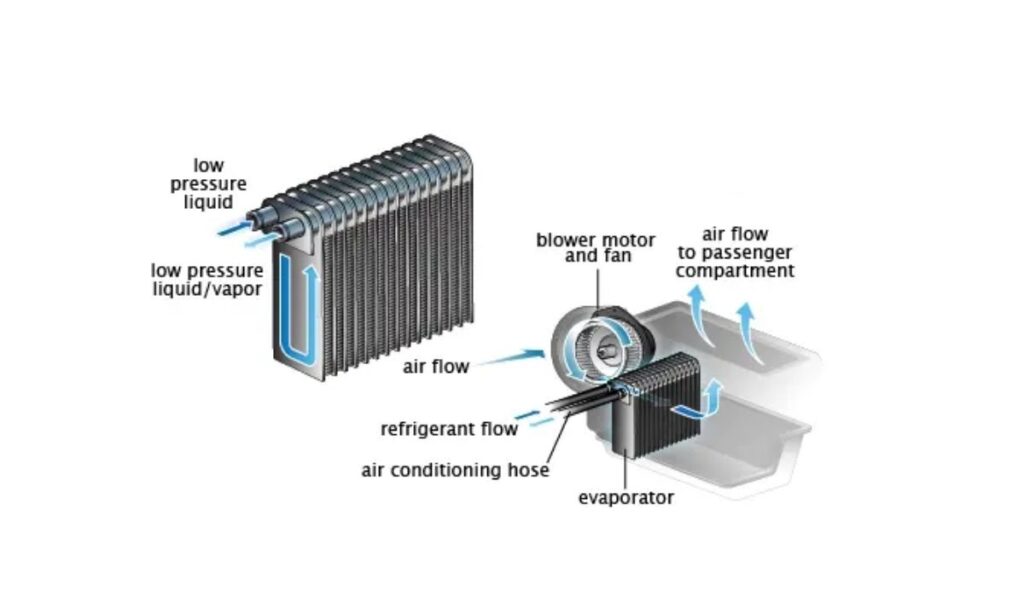Ever wonder where all that amazing cold air in your car actually comes from? Meet the unsung hero tucked away behind your dashboard: the air conditioning evaporator (A/C evaporator)! This crucial component is where the real magic of cooling happens. It receives incredibly cold, expanding refrigerant gas from its liquid state. As cabin air blows across its super-chilly surface, the evaporator absorbs heat from that air. The result? Delightfully cooled air that then gets pushed through your dashboard vents, making your ride comfortable!
But what happens when this heat-absorbing superstar starts to falter? Your cool comfort can quickly turn into a warm, sometimes smelly, nightmare!

How to Tell if Your Air Conditioning Evaporator Is Failing
Because the evaporator is deep within your car’s dash, its symptoms might seem a bit mysterious at first. Here’s what to watch out for:
- Weak Cool Air (or No Cold Air At All) from the System:
- This is the most common and frustrating sign. If your A/C used to be a champ but now only blows lukewarm air, or perhaps air that’s only “coolish” but never truly cold, a failing evaporator is a prime suspect. If it can’t effectively absorb heat from the cabin air, you simply won’t get that refreshing chill.
- Strange, Musty, or Sweet Odor When Using the Heat or A/C:
- This is the tell-tale sign that often points directly to the evaporator! Over time, moisture can accumulate on the evaporator’s fins. If it’s not draining properly, this damp environment becomes a breeding ground for mold, mildew, and bacteria. The result is a distinct musty, moldy, or even slightly sweet smell blowing through your vents whenever you run the A/C or even the heater. It’s truly unpleasant and can even irritate allergies!
- Damp Spots or Excessive Condensation Inside the Cabin (Rare, but Possible):
- While less common, if the evaporator’s drain is completely blocked, condensed moisture might back up and lead to dampness on your floor mats or strange pooling inside the cabin. This is a severe symptom of a clogged drain, often linked to the evaporator.
How to Deal with a Bad A/C Evaporator: The Professional Approach
Dealing with a bad A/C evaporator is quite a complex job, primarily because of its sneaky location. This is definitely one to leave to the experts!
- Detecting Leaks is a Challenge (It’s Buried Deep!):
- Here’s the kicker: it’s incredibly difficult to detect leaks in the A/C evaporator because it’s usually tucked away deep inside the heater/A/C case, behind your vehicle’s dashboard. This means a visual inspection for leaks is almost impossible without significant disassembly.
- To accurately verify if an evaporator is leaking, a technician often needs to perform specialized leak checks using UV dye and sniffers. In many cases, it may even be necessary to partially or totally remove the dashboard just to gain access for diagnosis or replacement. This is a very labor-intensive process!
- Replacement is Usually the Only Option for Leaks:
- If an evaporator fails a leak check (meaning it’s losing refrigerant), it will need to be replaced. Unfortunately, unlike some other parts, evaporators with internal leaks are rarely repairable.
- Always Replace the Accumulator or Receiver-Drier Too!
- This is a crucial piece of professional advice: we highly recommend replacing the A/C accumulator or receiver-drier whenever the A/C evaporator is replaced. Why? Because the accumulator/receiver-drier acts as the moisture and debris filter for the entire A/C system. When the system is “opened up” for evaporator replacement, moisture from the outside air inevitably enters. A brand new accumulator/receiver-drier will ensure the repaired system stays clean, dry, and healthy for the long run, preventing future problems and protecting your new evaporator and compressor.

Your Repair Advisor’s Take:
Your A/C evaporator is the unseen workhorse turning hot cabin air into cool comfort. When it starts to fail, you’ll feel it (or smell it!) immediately. Due to its hidden location and the specialized tools needed for diagnosis and replacement, fixing a bad evaporator is a job best suited for a qualified technician.
Don’t ignore that strange smell or weak air! A failing evaporator isn’t just uncomfortable; a leak can damage other expensive A/C components over time.
For accurate diagnosis, safe handling of refrigerants, and a lasting repair, always consult a qualified automotive A/C technician. They have the expertise to get deep into your dashboard, properly fix the issue, and ensure your A/C system is blowing perfectly clean, cold air again. Get back to enjoying your drives – schedule a professional A/C system diagnostic today!
